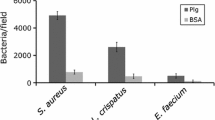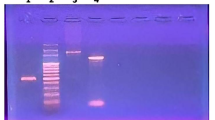Summary
In order to test the biotechnological potential of the cellular slime mould Dictyostelium discoideum the cDNA coding for human antithrombin III was expressed in this microorganism. The 1392-bp antithrombin III cDNA was fused to the N-terminal coding part of the D. discoideum actin 6 gene. In constructs carrying this artificial N-terminal coding region only low amounts of antithrombin III were detected. However, constructs from which all actin coding nucleotides were removed produced significant amounts of antithrombin III, most of which was secreted into the culture broth. Stationary cultures (1.5 × 107 cells/ml) of certain stable transformants accumulated up to 1.0 μg antithrombin III/ml culture medium within 24 h. The recombinant protein has a slightly smaller molecular weight in sodium dodecyl sulphate-polyacrylamide gels than authentic plasma antithrombin III and it is glycosylated, as determined by concanavalin A labelling.
Similar content being viewed by others
References
Ahern KG, Howard PK, Firtel RA (1988) Identification of regions essential for extrachromosomal replication and maintenance of an endogenous plasmid in Dictyostelium. Nucleic Acids Res 16:6825–6837
Bock SC, Wion KL, Vehar GA, Lawn RM (1982) Cloning and expression of the cDNA for human antithrombin III. Nucleic Acids Res 10:8113–8125
Bröker M, Ragg H, Karges HE (1987) Expression of human antithrombin III in Saccharomyces cerevisiae and Schizosaccharomyces pombe. Biochim Biophys Acta 908:203–213
Chandra T, Stackhouse R, Kidd VJ, Woo SLC (1983) Isolation and sequence characterization of a cDNA clone of human antithrombin III. Proc Natl Acad Sci USA 80:1845–1848
Chang AC, Williams KL, Williams JG, Ceccarelli A (1989) Complementation of a Dictyostelium discoideum thymidylate synthase mutation with the mouse gene provides a new selectable marker for transformation. Nucleic Acids Res 17:3655–3661
Clarke M, Kayman SC, Riley K (1987) Density dependent induction of discoidin I synthesis in exponentially growing cells of Dictyostelium discoideum. Differentiation 34:79–87
Colau B, Cravador A, Loriau R, van Elsen A, Hoylaerts M, Jacobs P, Herzog A, Bollen A (1985) Molecular cloning, sequencing and expression of a cDNA coding for human antithrombin III. Protides Biol Fluids 33:157–160
Devine JM, Williams JG (1982) Characterization of sequence elements at the 5′-end of a discoidin I gene isolated from Dictyostelium discoideum. Nucleic Acids Res 10:1231
Devine JM, Tsang AS, Williams JG (1982) Differential expression of the members of the discoidin I multigene family during growth and development of Dictyostelium discoideum. Cell 28:793
Dingermann T, Amon E, Williams KL, Welker DL (1987) Chromosomal mapping of tRNA genes from Dictyostelium discoideum. Mol Gen Genet 207:176–187
Dingermann T, Reindl N, Werner H, Hildebrandt M, Nellen W, Harwood A, Williams J, Nerke K (1989) Optimization and in situ detection of Escherichia coli β-galactosidase gene expression in Dictyostelium discoideum. Gene 85:353–362
Dynes JL, Firtel RA (1989) Molecular complementation of a genetic marker in Dictyostelium using a genomic-DNA library. Proc Natl Acad Sci USA 86:7966–7979
Early A, Williams J (1987) Two vectors which facilitate gene manipulation and a simplified transformation procedure for Dictyostelium discoideum. Gene 59:99–106
Egelhoff TT, Brown SS, Manstein DJ, Spudich IA (1989) Hygromycin resistance as a selectable marker in Dictyostelium discoideum. Mol Cell Biol 9:1965–1968
Gomer R, Datta S, Mehdy M, Crowley T, Sivertsen A, Nellen W, Reymond C, Mann S, Firtel RA (1985) Regulation of cell-type-specific gene expression in Dictyostelium. Cold Spring Harbor Symp Quant Biol 50:801–812
Howard P, Ahern K, Firtel RA (1988) Establishment of a transient expression system for Dictyostelium discoideum. Nucleic Acids Res 16:2613–2623
Jannsens PMW, Haastert PJM van (1987) Molecular basis of transmembrane signal transduction in Dictyostelium discoideum. Microbiol Rev 51:396–418
Kessin RH (1988) Genetics of early Dictyostelium discoideum development. Microbiol Rev 52:29–49
Knecht D, Cohen S, Loomis W, Lodish H (1986) Developmental regulation of Dictyostelium discoideum actin gene fusions carried on low-copy and high-copy transformation vectors. Mol Cell Biol 6:3973–3983
Laemmli UK (1970) Cleavage of structure proteins during assembly of the head of bacteriophage T4. Nature 227:680–685
Loomis WF (1982) The development of Dictyostelium discoideum. Academic Press, New York
Miller-Andersson M, Borg H, Andersson L-O (1974) Purification of antithrombin III by affinity chromatography. Thromb Res 5:439–452
Nellen W, Firtel RA (1985) High copy number transformants and co-transformation in Dictyostelium. Gene 39:155–163
Nellen W, Silan C, Firtel RA (1984) DNA-mediated transformation in Dictyostelium discoideum: regulated expression of an actin gene fusion. Mol Cell Biol 4:2890
Nellen W, Silan C, Firtel RA (1984) DNA-mediated transformation in Dictyostelium discoideum: regulated expression of an actin gene fusion. Mol Cell Biol 4:2890
Noegel A, Welker DL, Metz BA, Williams KL (1985) Presence of nuclear associated plasmids in the lower eukaryote Dictyostelium discoideum. J Mol Biol 185:447–450
Peterson CB, Finaly TH, Blackburn N (1985) Isolation and characterization of an antithrombin III variant with reduced carbohydrate content and enhanced heparin binding. J Biol Chem 260:610–615
Prochownik EV, Orkin SH (1984) In vivo transcription of a human antithrombin III “minigene”. J Biol Chem 259:15386–15392
Prochownik EV, Markham AF, Orkin SH (1983) Isolation of the cDNA clone for human antithrombin III. J Biol Chem 258:8389–8394
Prochownik EV, Bock SC, Orkin SH (1985) Intron structure of the human antithrombin III gene differs from that of other members of the serine protease superfamily. J Biol Chem 260:9608–9612
Rosenberg RD (1983) Antithrombin III, biochemistry, function, assay and clinical significance. Ann Univ Sarav Med 3:13–14
Sanger F, Nicklen S, Coulson A (1977) DNA sequencing with chain termination inhibitors. Proc Natl Acad Sci USA 74:5463–5467
Schaap P (1986) Regulation of size and pattern in the cellular slime molds. Differentiation 33:1–16
Schiele U, Heuck CC (1985) The role of the carbohydrate moiety for the inhibitory activity of antithrombin III. Thromb Res 39:143–144
Stephens AW, Siddiqui A, Hirs CHW (1987) Expression of functional active human antithrombin III. J Biol Chem 84:3886–3890
Vieira J, Messing J (1982) The pUC plasmid, and M13mp7-derived system for insertion mutagenesis and sequencing with synthetic universal primers. Gene 19:259–268
Watts D, Ashworth J (1970) Growth of myxamoebae of the cellular slime mould Dictyostelium discoideum in axenic culture. Biochem J 119:171–174
Welker DL, Williams KL (1982) A genetic map of Dictyostelium discoideum based on mitotic recombination. Genetics 109:691–710
Zettlmeissl G, Ragg H, Karges HE (1987) Expression of biologically active human antithrombin III in chinese hamster ovary cells. Bio/Technology 5:720–725
Author information
Authors and Affiliations
Additional information
Offprint requests to: T. Dingermann
Rights and permissions
About this article
Cite this article
Dingermann, T., Troidl, EM., Bröker, M. et al. Expression of human antithrombin III in the cellular slime mould Dictyostelium discoideum . Appl Microbiol Biotechnol 35, 496–503 (1991). https://doi.org/10.1007/BF00169756
Received:
Accepted:
Issue Date:
DOI: https://doi.org/10.1007/BF00169756




